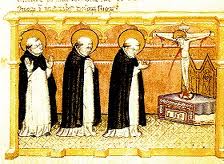Over the last month, I have been thinking about the relationship of body and prayer. At the Maryland March for Life in Annapolis, I fell in step with a woman who looked to be in her seventies’ using a cane and keeping a good pace as we walked up the long hill toward Lawyers’Mall. I wondered what made her drive through rush hour traffic to Annapolis to walk with us. Surely, her prayer would have been no less powerful had she chosen to stay at home and pray. A few days later, driving through DC, stopped at a traffic light, a young woman, standing perfectly still on the sidewalk caught my attention. Actually, the rosary she was holding is what caught my eye. Why, I thought, did she choose this spot and then I saw it. She was praying as part of the 40 Days for Life Campaign, at the Planned Parenthood Clinic. Two weeks ago, hundreds gathered in front of Health and Human Services to raise their voice in prayer and petition. Last Saturday, more than 200 young adults traced a 12 mile path through the city on the Seven Church pilgrimage in preparation for Holy Week. On Sunday, parishioners took palms and processed through parking lots, along sidewalks and into church. On Friday, at a number of parishes in the archdiocese, people will gather to follow the stations through local neighborhoods. All together, we seem to be a church in motion, on the move! Not just on the move, but on pilgrimage and more importantly, in prayer. At certain times, it just seems right to raise our minds, hearts and bodies in prayer.
In the tradition of St. Dominic
It seems right because just as we experience the presence of God through our bodily senses, our bodies themselves can be an expression of prayer. Saint Dominic, founder of the Order of Preachers teaches us that “gestures of the body powerfully dispose the soul to prayer.” The Dominican Family captured “nine ways of prayer” that were the practice of Dominic, not just in communal prayer but also as part of his private prayer. I discovered this booklet when I was a student and it has deepened my appreciation for making my posture an extension of my prayer. Dominic would have been right at home in any one of our rallies, walks or processions because pilgrimage is just one of nine ways of prayer.
Triduum Prayer
As we enter the celebration of the Triduum, we practice many of the bodily expressions of prayer. Thursday, we will be invited to kneel in adoration of the Blessed Sacrament—to watch and wait with our Lord. On Good Friday, many of us will gaze on the Stations of the Cross as we commemorate our Lord’s passion. Our priests will prostrate themselves in front of the altar and we will be invited to venerate the cross, by kneeling or kissing our touching the feet of our Lord. At the Vigil, our catechumens will kneel in the saving waters of Baptism or bend and receive the life-giving water as it is poured over their heads.
What of the nine ways of prayer might you be able to make a part of your Triduum. If you have not fasted as much or as well as you hoped, Friday is the perfect day to practice the prayer of the bodily discipline. While kneeling is the traditional form of prayer before the Blessed Sacrament, Dominic’s fifth way of prayer is to stand before the altar, perfectly erect, deeply reverent. The seventh position is a familiar one of hands raised in praise, is it an expression that you can use in personal prayer? In his eighth posture, study becomes prayer as he sits and contemplates God’s word.
As we walk with Jesus through his passion and death and as his body becomes for us the gift of our salvation, we are invited to pray in body, mind and spirit.


As a person who wandered in a non denominational faith, then joined the Church eight years ago in my fifties, I have a lot to learn.
I do try to pace myself and this is a good challenging piece arriving in a very timely manner.
Thank you.
Thanks, Susan for this thought-provoking piece. I had never made the connection between St. Dominic’s bodily prayer and some of the more ‘athletic’ actions of the Triduum liturgies. Speaking for myself, I am leery of that Good Friday prostration because I fear I may not be able to get up! On a spiritual level, perhaps it parallels our fear to ‘humble ourselves’ lest we not share in the resurrection! 🙂
Coming from the OP family, I appreciate the compliment. I am sure you are not alone among priests who have a concern for a graceful prostration! I think with all of these postures, humility and reverence are at the heart of it and they are always graceful!